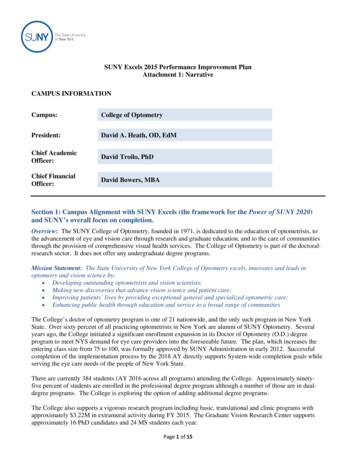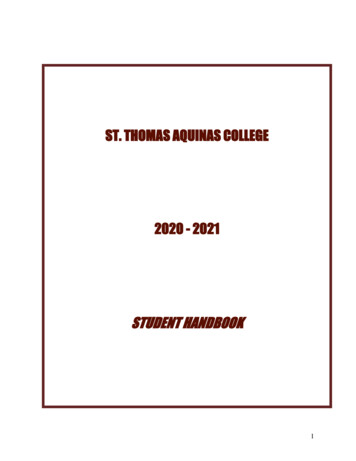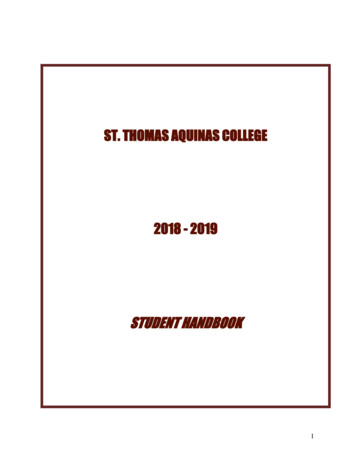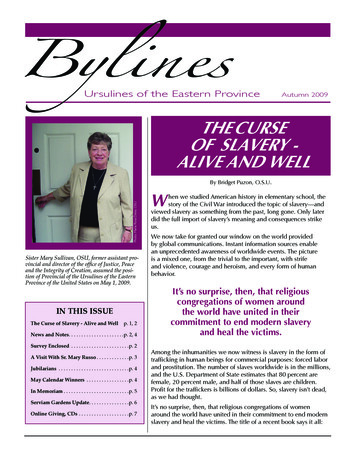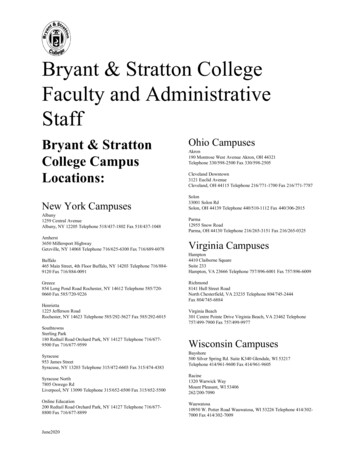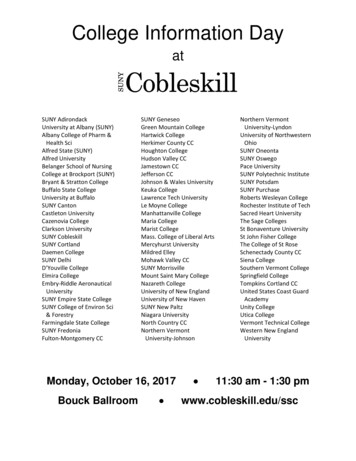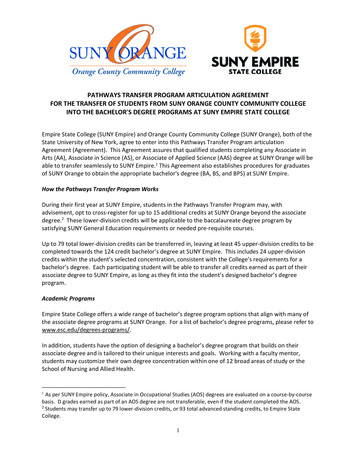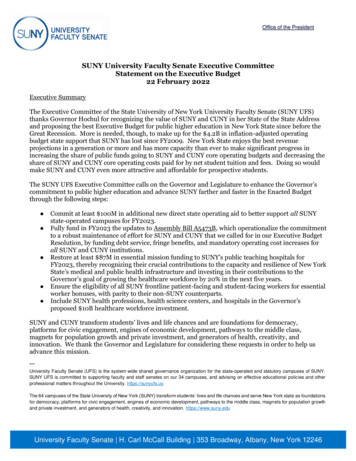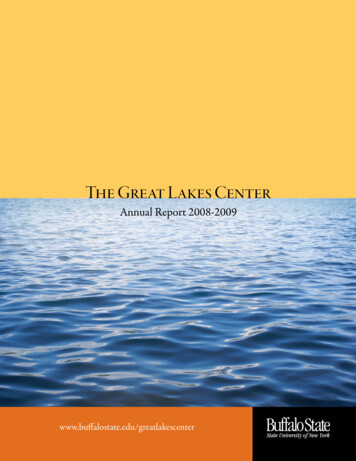
Transcription
The Great Lakes CenterAnnual Report 2008-2009www.buffalostate.edu/greatlakescenter
In memory of Captain John Freidhoff Boat Christening Ceremony, May 2009New Research Vessel purchased by Research Foundation
TheNearshoreandOffshoreLake ErieNutrientStudy
ContentMISSION. 2HIGHLIGHTS. 2I. STAFF. 3GLC Personnel.3GLC Affiliates.3Collaborators.4Professional Development Activities.6II. RESEARCH ACTIVITIES. 7Aquatic Ecology and Ecosystems Research.7Water Quality/Watershed Studies.11Environmental Toxicology.11Grants and Funding. .13III. EDUCATION. 16Classes Taught.16Lectures presented at the Field Station.16Graduate Program.16Degree(s) Granted.17Advising Undergraduate and Graduate Students.17Other Educational Activities.17IV. FIELD LABORATORY ACTIVITIES. 17Improvements to the Infrastructure.18Research Vessels.18Instructional Support. .18V. NEW INITIATIVES. 19Strategic Plan for 2009-2014.19Great Lakes Center MS Program in Great Lakes Ecosystems.20Publication of GLC Annual Reports. .20Seminar. .20VI. PUBLICATIONS AND PRESENTATIONS. 21Refereed Journal Publications (Published).21Refereed Journal Publications (Accepted).22Refereed Journal Publications Submitted (in Review).23Conference Proceedings and Other Non-refereed Publications (Published).24International/National Conference Presentations.24Conference Presentations (Non-Refereed).26Invited Talks. .27VII. SERVICE ACTIVITIES. 28
2008-2009 Annual ReportGreat Lakes Center – Buffalo State CollegeMISSIONThe Great Lakes Center (GLC) mission is to improve the quality of the environment by providingthe best possible science to decision-makers concerned with the health and sustainability of resources, witha primary focus within the Great Lakes and their watersheds. This is accomplished through high qualityresearch, informed and current graduate and undergraduate education, and dissemination of information tothe public through outreach. The Center is committed to improving human-environment interactions inthe Great Lakes ecosystem guided, in part, by an understanding of the evolutionary and ecological processesand patterns acting on the system. Although the main focus of the research in the GLC concentrates on theGreat Lakes basin, nation-wide and international projects are also considered of high priority as they exposeGLC scientists to the cutting edge of modern science, facilitate collaboration, and greatly increase visibilityof the Center’s activity in the scientific community.HIGHLIGHTSOver the last year, the Great Lakes Center saw sustained activity and productivity in all areas of ouroperations, including research, education and service. We continued our excellence in research conductedby GLC personnel and in collaboration with other faculty from Buffalo State College, as well as otheruniversities in North America, Europe, and South America. Our researchers have published 11 manuscripts, 10 were accepted for publication, and 10 weresubmitted to peer-reviewed journals. In addition, 3 manuscripts were published in non-refereedvenues. Presented 37 talks, including: 23 at national/international conferences, 7 invited talks, and 7presentations in non-refereed venues. Submitted 15 grant proposals (total requested amount 4,170,183). Ten projects for research and education (including multi-year grants) are currently funded in theGLC totaling 1,724,514. Request for additional funding for the Great Lakes Center for 1,050,000 was submitted to NewYork Senate. Center personnel acted as advisers to graduate students, and taught 9 graduate and undergraduatecourses. All of the Center resources, including vessels, sampling equipment, field station labs and theconference room, the environment toxicology lab, and the aquatic ecology lab were used extensivelyto train undergraduate and graduate students. A new 27 foot research vessel, the John J. Friedhoff was purchased by the Research Foundation forthe GLC. Our strategic plan for 2009 – 2014 was reviewed and approved by the school of Natural and SocialSciences, Dean’s Council, and the Vice President’s Council. We made a substantial progress toward development of a Master of Science program in the GreatLakes Ecosystem.
I. StaffIn December 2008 Sheila Christopher accepted a Senior Research Scientist position in Virginia WaterResources Research Center and left GLC. In August of 2008 Sergey E. Mastitsky joined GLC as a researchscientist on Research Foundation line. Sergey graduated from Belarusian State University and got hisdoctoral degree in Hydrobiology from the Belarusian Academy of Science in 2004. He is an expert in thespread, ecology, and parasites of aquatic exotic species.GLC PersonnelDirector: Alexander Y. KaratayevResearch Scientists:Subodh Kumar, Director of the Laboratory of Environmental ToxicologyLyubov BurlakovaMark ClapsadlSergey MastitskyJagat MukherjeeChristopher PennutoAlicia Pérez-FuentetajaCharlotte RoehmSecretary: Cathleen NascaField Station Director, Research Associate & Ships: Captain Mark ClapsadlResearch Fleet Manager & Ships: Captain Caleb P. BasilikoField Station Technician: Katie HastingsResearch Assistants: Christopher JanikWork Study: Jocelyn HeltaAma AchempongGLC AffiliatesRandal Snyder, Associate Professor, Buffalo State CollegeHoward Riessen, Professor, Biology Department, Buffalo State CollegeGary Pettibone, Professor, Biology Department, Buffalo State CollegeKimberley Irvine, Professor, Geography and Planning Department, Buffalo State CollegeKelly Frothingham, Associate Professor and Chair, Geography and Planning Department, Buffalo State CollegeJill Singer, Professor, Earth Sciences and Science Education Department and Director of the Buffalo StateOffice of Undergraduate Research.
CollaboratorsAt New York State:––Daniel Molloy, Associate Scientist, New YorkState Museum;––Denis Meyer, Research Scientist, New YorkState Museum;––Dianna Padilla, Professor, Department ofEcology and Evolution, State University ofNew York at Stony Brook––Edward Mills, Professor and Director of theCornell Biological Field Station, CornellUniversity––Dawn Dittman, Ecologist, USGS GreatLakes Science Center, Tunison Laboratory ofAquatic Science, Cortland, NY––Joseph Makarewicz, Distinguished ServiceProfessor Environmental Science and Biology,State University of New York, Brockport, NY––Joe Atkinson, Professor EnvironmentalEngineering, State University of New York atBuffalo––Bill Edwards, Assistant Professor of Biology,Niagara University––Paul Patrick, Senior Consultant, SenesConsulting, LTD––Mike Goehle, Regional ANS Coordinator,USFWS––Gregory Boyer, Director, Great Lakes ResearchConsortium, Professor of Biochemistry,State University of New York, College ofEnvironmental Science and Forestry, Syracuse,NY––Robert Baier, Professor and ExecutiveDirector of the Industry/University Center forBiosurfaces, University at Buffalo––Diana S. Aga, Associate Professor, ChemistryDepartment, University at Buffalo.––Katherine Alben, Senior Scientist, WasdworthInstitute, Albany, NYAt Other US Institutions:––Walter Hoeh, Associate Professor,Evolutionary, Population, and SystematicBiology Group, Department of BiologicalSciences, Kent State University, Kent, Ohio––Jake Vander Zanden, Associate Professor,Center for Limnology, University ofWisconsin, Madison, Wisconsin––Stanley Dodson, Professor, Department ofZoology, University of Wisconsin, Madison,Wisconsin––Richard Lathrop, Wisconsin Department ofNatural Resources, University of Wisconsin,Madison, Wisconsin––James Kitchell, Professor and Director ofthe Center for Limnology, University ofWisconsin, Madison––Marsha May, Texas Nature Trackers, WildlifeDiversity Branch, Texas Parks and WildlifeDepartment, Austin, Texas––Tom Miller, Director, Lamar Bruni VergaraEnvironmental Science Center, LaredoCommunity College, Laredo, Texas––Heidi Bunk, Lake Biologist, Southern Region,Wisconsin Department of Natural Resources,Waukesha, Wisconsin––Donald Jerina, Head, Laboratory ofBioorganic Chemistry NIDDK, NationalInstitutes of Health, Bethesda, Maryland––Kenneth Laali, Professor in Chemistry, KentState University, Kent, Ohio––David DeMarini, EnvironmentalCarcinogenesis Division (B-143-06), U.S.Environmental Protection Agency, ResearchTriangle Park, North Carolina.––Dave Evers, Assistant Professor, BiologyDepartment, University of Southern Maine––Mark Green, Associate Professor, BiologyDepartment, Saint Joseph’s College of Maine––Alan van Arsdale, Senior Ecologist, US EPA.––Joseph Conroy, Ohio State University,Columbus, Ohio
––Jack Kramer, National Center for WaterQuality Research, Heidelberg University,Tiffin, Ohio––Gerald Matisoff, Dept of Geological SciencesDepartment Chair, Case Western ReserveUniversity, Cleveland, Ohio––Darren Bade, Kent State University, Kent,OhioInternational:––Demetrio Boltovskoy, Professor, University ofBuenos Aires, Argentina.––Sergei Olenin, Professor, Coastal Researchand Planning Institute, Klaipeda University,Lithuania.––Francisco Sylvester, Postdoctoral Fellow,University of Windsor, Canada.––Charles Ramcharan, Associate Professor,Department of Biology, Laurentian University,Sudbury, Ontario, Canada.––Jan Ciborowski, Professor, Department ofBiological Sciences, University of Windsor,Windsor, Ontario, Canada.––Frances Lucy, Associate Professor, Institute ofTechnology, Sligo, Ireland.––Tamara Makarevich, Associate Professor,Belarusian State University, Minsk, Belarus.––Vadim Panov, Adjunct Professor, St.Petersburg State University, St.-Petersburg,Russia.––Jan Karlsson, Climate Impacts ResearchCentre (CIRC), Department of Ecology andEnvironmental Science, Umeå University,Sweden––Reiner Giesler, Climate Impacts ResearchCentre (CIRC), Department of Ecology andEnvironmental Science, Umeå University,Sweden––Richard Soare, Department of Geography andPlanning, Concordia University, Montreal,Canada––Norman Yan, Professor, York University, York,Ontario, Canada.Professional DevelopmentActivitiesCaleb Basiliko: Obtained FCC marine radio operators license. Completed training for Master Divercertification. Attended and passed 200 tons upgrade classfor captain’s license. Began training for Dive Control Specialist. Attended training for vessel operators inTraverse City Michigan. Attended Coast Guard Industry Day for newrules updates.Lyubov Burlakova: Attended a workshop “How to Get Your ProposalFunded” sponsored by The Research Foundationof State University of New York and theUniversity Faculty Senate, October 6, 2008. Attended a workshop “The NSF Course,Curriculum and Laboratory ImprovementProgram”. Presenter: Jill Singer, ProgramDirector, NSF Division of UndergraduateEducation at the NSF. The Research Foundationof SUNY at Buffalo State College. April 13, 2009. Attended the National Science FoundationDay at Binghamton, NY. January 15, 2009. Participated in the United States ConferenceOn Teaching Statistics (USCOTS 2009),Ohio State University, Columbus, OH, June25th - 27th (Funded by Title III grant fromthe US Department of Education to improvethe quantitative/ mathematical performance ofstudents).Mark Clapsadl: Attended Bio-acoustics workshop at CornellUniversity June 1, 2009 Attended week long CTD training SeattleWashington Feb. 8-13 Received 50 ton USCG masters LicenseDecember 2008.
Alexander Karatayev: Attended a workshop “How to Get YourProposal Funded” sponsored by The ResearchFoundation of State University of New Yorkand the University Faculty Senate, October 6,2008.Kathleen Hastings: Attended Buffalo State Van Driver SafetyCourse Received NYS Boating Safety Certification Attended Field Station Boating Safety Course Attended a workshop “The NSF Course,Curriculum and Laboratory Improvement(CCLI) Program”. Presenter: Jill Singer,Program Director, NSF Division ofUndergraduate Education at the NSF. TheResearch Foundation of SUNY at BuffaloState College. April 13, 2009. Heartsaver First Aid Certification (AED/CPRtrained) Attended the National Science FoundationDay at Binghamton, NY. January 15, 2009.Charlotte Roehm: Attended a workshop “How to Get YourProposal Funded” sponsored by The ResearchFoundation of State University of New Yorkand the University Faculty Senate, October 6,2008Subodh Kumar: Attended the National Science FoundationDay at Binghamton, NY. January 15, 2009.Sergey Mastitsky: Attended a workshop “How to Get YourProposal Funded” sponsored by The ResearchFoundation of State University of New Yorkand the University Faculty Senate, October 6,2008 Attended a workshop “The NSF Course,Curriculum and Laboratory Improvement(CCLI) Program”. Presenter: Jill Singer,Program Director, NSF Division ofUndergraduate Education at the NSF. TheResearch Foundation of SUNY at BuffaloState College. April 13, 2009. Attended the National Science FoundationDay at Binghamton, NY. January 15, 2009. Attended a workshop “MaritimeMeteorology” sponsored by the Buffalo StateCollege Maritime Center, May 2, 2009 Enrolled in the Random drug Testing program Attended a workshop “The NSF Course,Curriculum and Laboratory Improvement(CCLI) Program” Presenter: Jill Singer,Program Director, NSF Division ofUndergraduate Education at the NSF. TheResearch Foundation of SUNY at BuffaloState College. April 13, 2009 Attended and completed the CommunityEmergency Response Training (CERT) courseDec, 2008
II. Research ActivitiesAquatic Ecology and Ecosystems ResearchMost of the aquatic ecology/ecosystems research is carried out at the GLC Field Laboratory, and focuses onthe Great Lakes and their tributaries, however, Center personnel are also involved in numerous projects inother states (e.g. Texas), as well as in Canada and Europe. We maintain active international collaborationwith world experts in invasion biology that allow us to be aware of future invaders, and concentrate ourlimited resources in order to minimize the negative effects of aquatic nuisance species.Current Projects:The nearshore and offshore Lake Erie nutrient study (NOLENS).Although the nutrient abatement strategies implemented in the Lake Erie watershed have reduced nutrientinputs to target levels, not all of the anticipated responses have been realized. The central basin hypoxia event(the ‘dead-zone’), extensive Cladophora growth in the eastern basin, and repeated outbreaks of nuisance algaein the western basin have all occurred since the reduction in nutrient inputs. This project documented thequantity of nutrients present in all biotic and abiotic compartments of the nearshore and offshore pelagicand benthic habitats and pathways for trophic transfer. We measured directly flux rates in the most rapidlycycling pools and use published, scientifically peer-reviewed nutrient flux rates for the remaining biota inthe system, coupled with published hydrodynamic models of particle transport, to assess whether the poolsof nutrients in the nearshore and offshore regions follow the predicted patterns of early lake mixing models.This project is in collaboration with National Center for Water Quality Research in Heidelberg University,Kent State University, Ohio State University, and Case Western Reserve University.Lake Ontario Nearshore Nutrient Assessment.This is a multi-institutional, binational effort that is aimed at understanding the dynamics of a lake changingin response to impacts of climate change, non-indigenous species, and anthropogenic factors. This projectis in collaboration with SUNY Brockport, SUNY Buffalo, SUNY ESF, Niagara University, and University ofRochester.Senes.This project will determine biomass and coverage of benthic algae to field-verify satellite imagery on colorspectra from nearshore Lake Ontario near the FitzPatrick nuclear power facility.Goby Barriers.This project will determine the interaction between water velocity, substrate composition, and streambedslope on round goby swimming performance. Ultimately, these data may assist in barrier design to reduceupstream passage or allow us to predict which streams are most at risk to further invasion.Amphipod intraguild predation.This project will assess intraguild predation as a mechanism promoting successful invasion of non-nativebenthic amphipod species.Crayfish predator avoidance.This project will assess the importance of learning in predator avoidance by native and invasive crayfish.
Predict the characteristics and spread of aquatic invertebrate invaders.Long-term experience of studying exotic species has allowed us to bring together an international teamcurrently working on a project to predict future invaders. For 98 freshwater, marine, and brackish species,we collected data on a wide range of biological and ecological parameters. Using this database, we will beable to employ a quantitative approach to address many important problems in invasion biology, and topredict a set of future scenarios that determine invasion success.Predict the potential effects of zebra mussels on benthic community and lake ecosystems ofMadison lakes.The objectives of this study are to: provide pre-invasion information on the community composition,density, biomass and production of benthic habitats in the Madison lakes; predict the effect of zebramussel invasion on benthic communities in the Madison lakes through comparisons with data obtainedin southeastern Wisconsin lakes and an extensive long-term database from Eastern European lakes; and toestimate the potential effect of zebra mussels on benthic and pelagic communities and associated fisheries inthe Madison lakes.Invasion paradox: who is the better invader – Dreissena rostriformis bugensis or Dreissenapolymorpha?Dreissena polymorpha (zebra mussel) and D. r. bugensis (quaggamussel) are both invaders, co-occur in their native habitat, andhave very different histories of invasion. We compared therates of spread of D. polymorpha and D. r. bugensis at differentspatial scales and contrasted differences in their ecological andpopulation characteristics to determine the relative importanceof these traits on the success and patterns of invasion forthese two species. Although in many waterbodies D. r.bugensis have been reported to outcompete D. polymorpha,Lyubov Burlakova and Sergey Mastitsky set up anlocal competition may be much more dependent upon localexperiment to study growth and mortality of zebraenvironmental conditions and will determine which dreissenid and quagga mussels under different thermal regimes.species will become dominant in a given waterbody, and thuslikely to attach to boats and spread. To assess which biological traits allowed different dreissenid species todominate under different environment conditions, we studied reproduction dynamics, growth rate and larvalsettlement of zebra and quagga mussels in Lake Erie.Parasites of aquatic exotic species: an underestimated threat to invaded ecosystems.Collecting molluscs in Ontario watershed to studyparasites of exotic species. Sergey Mastitsky, LyubovBurlakova, and Alexander KaratayevExotic species may serve as vectors of introduction for theirspecific parasites, including highly pathogenic ones, and mayalso become hosts for aboriginal disease agents. This can resultin catastrophic outbreaks of the parasitic diseases that wouldotherwise not have existed in the introduced areas. A clearunderstanding of the mechanisms and patterns of the spread ofexotic species and their associated parasites is therefore required topredict and prevent such outbreaks. We are assembling a databaseof parasites of aquatic invaders and conducting field study todetermine the prevalence and intensity of infection of aquaticexotic invertebrates by parasites in their native and invaded ranges.
Diversity, distribution andlong-term changes infreshwater Unionidae in Texas.Freshwater Unionidae is the mostrapidly declining faunal group in theUS, including Texas. Among the 52species known in Texas, there are atleast 26 species that require specialEstimating the size of the single existingattention, including six endemicpopulation of endemic Quadrula petrinain Concho River, August 2008and one federally listed endangeredspecies. Currently we are funded by the U.S. Fish and Wildlife Service andTexas Parks and Wildlife Department (State Wildlife Grants, 2004 - 2009)to conduct statewide surveys of the rare and the most valuable Unionidaepopulations in Texas. We are assembling a database that will include, alongwith our own data, all published data on unionid diversity and abundance inTexas. This comprehensive dataset will be used to analyze the current statusand long-term dynamics of unionid diversity across the whole state.Discovery of Texas endemicsQuadrula houstonensis andTruncilla macrodon in ColoradoRiver, May 2009South American channeled applesnail (Pomacea insularum).This snail is of special concern for the USA coastal ecosystems and rice industry. The goals of our researchare to determine Pomacea insularum current distribution, and to estimate the rate, patterns and vectors ofapplesnail spread in Texas. These data will allow prediction of their potential spread in Texas, and the US.With our four years of research experience in the biology and ecology of this invader, we are acting as aresource for information for agencies in other states.Limnoperna research in South America.Limnoperna fortunei, a bivalve mollusc native to China, is now rapidly spreading in South America. As withDreissena (the zebra mussels), Limnoperna has rapidly become a major nuisance for many industries andpower plants, and its impact on the environment may be even stronger than that of Dreissena. Togetherwith colleagues from Argentina, we conducted the first quantitative survey of Limnoperna in Rio TerceroReservoir, analyzed mussel coverage on different substrate types, estimated the overall population size, andstudied their effect on the benthic community. Our data will help us to predict the potential effect ofLimnoperna on aquatic ecosystems in the US.Endocrine-disrupting effects of persistent organic pollutants in fish populations fromeastern Lake Erie.We have sampled steelhead trout, common carp, and largemouth bass from eastern Lake Erie to determinelevels of the endocrine disrupting pollutants PCB and PBDE, which have estrogenic effects on exposedpopulations of fish. We assess the impacts to reproduction of these chemicals by measuring in male fishthe levels of a unique female protein synthesized for egg production. The effects of these pollutants on fishinclude the alteration of their sexual characteristics and reproductive fitness.
Food web-mediated transport and bioaccumulationof flame retardants (PBDE) in sport fish from easternLake Erie.We are sampling sport fish(walleye, lake trout, steelheadtrout, smallmouth bass) andtheir forage fish (gobies, emeraldshiners, yellow perch, smelt), andLisa Zimmerman (University at Buffalo), Alicia Pérez- forage invertebrates (dreissenids,Fuentetaja, and students Beryl Ankrah and Jessicaamphipods and zooplankton), waterWuerstle collecting tissue samples to determineand sediment, to determine PBDEPBDE concentration in Steelhead Trout.congener load at all these trophiclevels. Stable isotopic determination of organisms will help us determine theirposition in the food web and bioaccumulation coefficients for these chemicalsof concern.Graduate students Beryl Ankrahand Jessica Wuerstle takingsamples of trout stomachcontents for PBDE analysis.Botulism type E in the Great Lakes.Workshop on writing a proposal to study Botulism E in Great Lakes, June2009. Alicia Pérez-Fuentetaja, Lyubov Burlakova, Denise Mayer (NYSMuseum), Mark Clapsadl, Daniel Molloy (NYS Museum), Sergey Mastitsky,and Kimi Nishikawa (NYS Museum).We have seven years of research experiencein the new and ongoing botulism outbreaksin the Great Lakes basin. Our currentrole in this topic is to act as a resource forinformation for federal (EPA) and stateagencies (DEC, NY-F&WS) as well as theGreat Lakes Research Consortium and to thegreater research community. Our expertiseincludes sources of type E botulism in theGreat Lakes and food web transmission.The role of the zooplankton Bosmina freyi in acidifying lake ecosystems.This organism plays a vital role in the future of lakes that are exposed to acid rain and deforestation and,therefore, have declining calcium levels. Bosmina is small zooplankton species that has low Ca requirementsand, therefore, can potentially replace the common grazer Daphnia in many of the thousands of lakes that arepart of the Canadian Granitic Shield, altering permanently the structure of the food webs. We are workingwith researchers at York University, Ontario, to compare in a highly replicated experiment the competitiveand environmental advantages of Bosmina in lakes suffering from decalcification and Climate Change.Long Term Monitoring on Lake Erie.This multiagency effort aimed at building adatabase of biotic and abiotic information frommultip
of State University of New York and the University Faculty Senate, October 6, 2008. Attended a workshop "The NSF Course, Curriculum and Laboratory Improvement Program". Presenter: Jill Singer, Program Director, NSF Division of Undergraduate Education at the NSF. The Research Foundation of SUNY at Buffalo State College. April 13, 2009.


